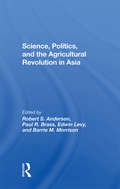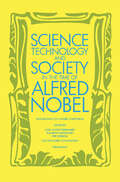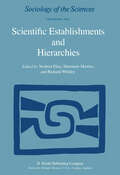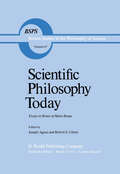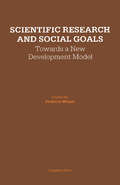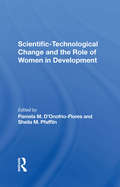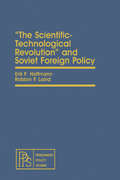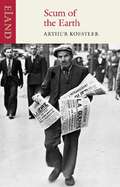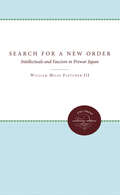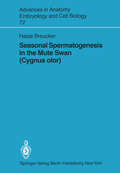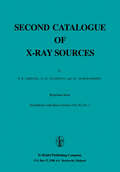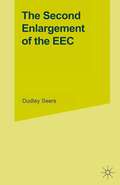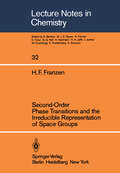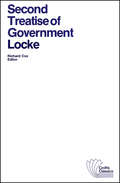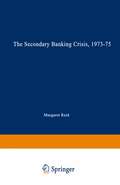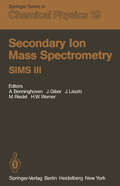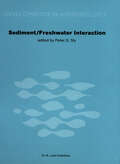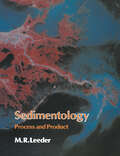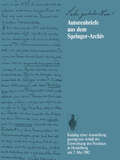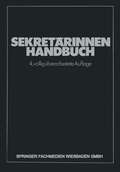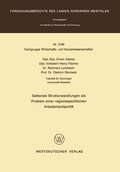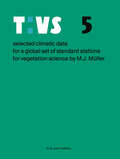- Table View
- List View
Science, Politics, And The Agricultural Revolution In Asia
by Robert S Anderson Paul R Brass Edwin Levy Barrie MorrisonAgriculture in southern Asia has undergone a radical transformation in recent years, one that continues to alter the political economy of the area. Beyond the familiar elements of the green revolution, there has been an increase in resource exploitation for food production, and a rise in the economic and political strength of food producers, as wel
Science, Technology & Society in the Time of Alfred Nobel: Nobel Symposium 52 Held at Björkborn, Karlskoga, Sweden, 17-22 August 1981 (Nobel Symposium)
by Carl Gustaf Bernhard E. Crawford P. SörbomThe papers contained in this volume were presented at the Nobel Symposium which marked the eightieth anniversary of the first award of the Nobel prizes in 1901. Leading scholars from many different fields of science and technology exchange viewpoints across interdisciplinary boundaries. Participants were chosen for their special knowledge of science and technology in the late nineteenth and early twentieth centuries and papers cover the period from the 1860s to the outbreak of the First World War.
Scientific Establishments and Hierarchies (Sociology of the Sciences Yearbook #6)
by Norbert Elias, Herminio Martins and Richard WhitleyIn recent years sociologists of sciences have become more interested in scien tific elites, in the way they direct and control the development of sciences and, beyond that, in which the organization of research facilities and resources generally affects research strategies and goals. In this volume we focus on scientific establishments and hierarchies as a means of bringing aspects of these concerns together in their historical and comparative contexts. These terms draw attention to the fact that much scientific work has been pursued within a highly specific organizational setting, that of universities and aca demic research institutes. The effects of this organizational setting as well as its power relations, and its resources in relation to governmental and other non-scientific establishments in society at large, deserve closer attention. One significant aspect of scientific establishments and hierarchies and of the power relations impinging upon scientific research, is the fact that the bulk of leading scientists have the professional career, qualifications and status of a professor. As heads or senior members of departments, institutes and laboratories, professors form the ruling groups of scientific work. They are the main defenders of scientific - or departmental - autonomy, accept or resist innovations in their field, play a leading part in fighting scientific controversies or establishing consensus. Even where research units are not directly controlled by professors, authority structures usually remain strongly hierarchical. These hierarchies too deserve attention in any explora tion of the social characteristics of scientific knowledge and its production.
Scientific Philosophy Today: Essays in Honor of Mario Bunge (Boston Studies in the Philosophy and History of Science #67)
by J. Agassi Robert S. CohenThis volume is dedicated to Mario Bunge in honor of his sixtieth birthday. Mario Bunge is a philosopher of great repute, whose enormous output includes dozens of books in several languages, which will culminate with his Treatise on Basic Philosophy projected in seven volumes, four of which have already appeared [Reidel, I 974ff. ]. He is known for his works on research methods, the foundations of physics, biology, the social sciences, the diverse applications of mathematical methods and of systems analysis, and more. Bunge stands for exact philosophy, classical liberal social philosophy, rationalism and enlightenment. He is brave, even relentless, in his attacks on subjectivism, mentalism, and spiritualism, as well as on positivism, mechanism, and dialectics. He believes in logic and clarity, in science and open-mindedness - not as the philosopher's equivalent to the poli tician's rhetoric of motherhood and apple pie, but as a matter of everyday practice, as qualities to cultivate daily in our pursuit of the life worth living. Bunge's philosophy often has the quality of Columbus's egg, and he is prone to come to swift and decisive conclusions on the basis of argu ments which seem to him valid; he will not be perturbed by the fact that most of the advanced thinkers in the field hold different views.
Scientific Research and Social Goals: Towards a New Development Model
by Federico MayorScientific Research and Social Goals: Towards a New Development Model is designed to contribute to the task of producing a development model, based on human needs, social goals, and the value of research. The book is organized into three sections: concepts and philosophy; methodological approaches; and practicalprograms in different parts of the world. These sections consist of a total of 19 chapters that discuss topics on national policy implications of the basic needs model; scientific progress and the social goals of science; an International Program on research and human needs; and the role of methodology in the research and human needs program. The contribution of research to human needs and an action program on research and human needs are also described.
Scientific-technological Change And The Role Of Women In Development
by Pamela D'onofrio-flores Sheila M PfafflinThis critique by women of male-generated and male-dominated technologies grows out of a consciousness of women as essential, yet unsalaried, participants in production processes. The authors document the ways in which women suffer from technological development in industrialized and developing countries and assess how technological developments perpetuate inequalities between nations, regions, classes, and sexes. They discuss the implementation of modern technology in agriculture and its effects on rural women, look at the position of women in the basic and applied sciences and in science policymaking, and analyze the place of women in selected technology-based industries.
Scientific-technological Change And The Role Of Women In Development
by Pamela D'onofrio-flores Sheila M PfafflinThis critique by women of male-generated and male-dominated technologies grows out of a consciousness of women as essential, yet unsalaried, participants in production processes. The authors document the ways in which women suffer from technological development in industrialized and developing countries and assess how technological developments perpetuate inequalities between nations, regions, classes, and sexes. They discuss the implementation of modern technology in agriculture and its effects on rural women, look at the position of women in the basic and applied sciences and in science policymaking, and analyze the place of women in selected technology-based industries.
The Scientific-Technological Revolution and Soviet Foreign Policy: Pergamon Policy Studies on International Politics
by Erik P. Hoffmann Robbin F. Laird""The Scientific-Technological Revolution"" and Soviet Foreign Policy explains the effects of the worldwide scientific-technological revolution (STR) on Soviet foreign policy under ""the collective leadership"" of Leonid Brezhnev. Organized into five chapters, this book carefully examines Soviet views of the relationship of STR with political, economic, and military dimensions of ""peaceful coexistence"" and ""detente."" This text also evaluates the impact of scientific discoveries, technological innovations, foreign economic relations, strategic arms development, and instability in Third World countries. Some of the functions performed by Soviet perspectives on scientific-technical change and international politics are also reported.
Scum of the Earth (Eland Travel Classics Ser.)
by Arthur KoestlerAt the beginning of the Second World War, Koestler was living in the south of France working on Darkness at Noon. After retreating to Paris he was imprisoned by the French as an undesirable alien even though he had been a respected crusader against fascism. Only luck and his passionate energy allowed him to escape the fate of many of the innocent refugees, who were handed over to the Nazis for torture and often execution. Scum of the Earth is more than the story of Koestler's survival. His shrewd observation of the collapse of French determination to resist during the summer of 1940 is an illustration of what happens when a nation loses its honour and its pride.
The Search for a New Order: Intellectuals and Fascism in Prewar Japan
by William Miles Fletcher IIIFletcher explains how three writers--Ryu Shintaro, Royama Masamichi, and Miki Kiyoshi--who were supporters of democratic socialism became ideologues for the East Asian bloc ideal that rationalized Japan's dominance of Asia after 1937, and he demonstrates how and why they designed the New Order movement of 1940. He concludes that the advocacy of fascism was a reasoned effort to respond to the ills of industrialization and the challenges of mobilization for war.Originally published in 1982.A UNC Press Enduring Edition -- UNC Press Enduring Editions use the latest in digital technology to make available again books from our distinguished backlist that were previously out of print. These editions are published unaltered from the original, and are presented in affordable paperback formats, bringing readers both historical and cultural value.
Seasonal Spermatogenesis in the Mute Swan (Advances in Anatomy, Embryology and Cell Biology #72)
by H. BreuckerOf all the classes in the animal kingdom, birds represent the best known. There are in total about 8600 living species, and the systematic study of this class is more or less complete. Extensive observations - to a large extent by amateur ornithologists - with respect to geographical distribution, life cycles, demands on and adaptations to the environment, breeding habits, migration, and so forth have contributed towards basic and more widely relevant knowledge, e. g. , in the areas of ethology, ecology, and evo lution and also in social biology (Hilprecht 1970; Farner and King 1971). Together, all these aspects are affected by the reproductive biology of birds, and studies have therefore been carried out for many years with special emphasis on this subject. How ever, until now this emphasis in avian reproductive biology has been physiological and in particular endocrinological (Murton and Westwood 1977; Roosen-Runge 1977). The morphology of the gonads has been treated in far less detail, and has been confined to a comparatively small number of species, compared with other classes of vertebrates. Reproduction is the section in the life cycle of an animal which is most dependent upon environmental conditions. Reproduction therefore usually takes place at a par ticular time, when stress for the adult animals is at its lowest and the chances of sur vival for the newborn are at their highest, i. e.
The Second Enlargement of the EEC: The Integration of Unequal Partners (Studies in the Integration of Western Europe)
by Dudley Seers Constantine VaitsosSecond-Order Phase Transitions and the Irreducible Representation of Space Groups (Lecture Notes in Chemistry #32)
by Hugo F. FranzenThe lecture notes presented in this volume were developed over a period of time that originated with the investigation of a research problem, the distortion from NiAs-type to MnP-type, the group-theoretical implications of which were investigated in collaboration with Professors F. Jellinek and C. Haas of the Laboratory for Inorganic Chemistry at the University of Groningen during the 1973-1974 year. This distortion provides the major example that is worked through in the notes. The subject matter of the notes has been incorporated in part in the lectures of a course in Solid State Chemistry taught several times at Iowa State University, and formed the basis of a series of lectures presented at the Max-Planck Institute for Solid State Research in Stuttgart during 1981- 19821 and as part of a Solid State Chemistry course taught during the spring of 1982 at Arizona State University in Tempe. I wish here to express my gratitude to the Max-Planck Institute for Solid State Research and to Arizona State University for the opportunity and support they provided during the time I was developing and writing the lecture notes of this volume. I wish also to thank the many colleagues and students who have offered comments and suggestions that have improved the accuracy and readability of the notes, and who have provided stimulation through discussion of the ideas presented here. am especially indebted to Professors C. Haas and F.
Second Treatise of Government: An Essay Concerning the True Original, Extent and End of Civil Government (Crofts Classics)
by John LockeThis essential volume features John Locke's hand-corrected text with an outstanding introduction to Locke's life and role in intellectual history, his principal works, and their purpose. Written by the editor, Richard Cox, the introduction also outlines the course of both treatises of government and analyzes the problems of interpretation. Also included are a list of the principal dates in the life of John Locke as well as a selected bibliography.
Secondary Ion Mass Spectrometry SIMS III: Proceedings of the Third International Conference, Technical University, Budapest, Hungary, August 30–September 5, 1981 (Springer Series in Chemical Physics #19)
by A. Benninghoven J. Giber J. Laszlo M. Riedel H. W. WernerFollowing the biannual meetings in MUnster (1977) and Stanford (1979) the Third International Conference on Secondary Ion Mass Spectroscopy was held in Budapest from August 31 to September 5, 1981. The Conference was attended by about 250 participants. The success of the 1981 Conference in Budapest was especially due to the excellent preparation and organization by the Local Organizing Committee. We would also like to acknowledge the generous hospitality and cooperation of the Hungarian Academy of Sciences. Japan was chosen to be the location for the next conference in 1983. SIMS conferences are devoted to two main issues: improving the application of SIMS in different and especially new fields, and understanding the ion formation process. Needless to say, there is a very strong interaction be tween these two issues. The major reason for the rapid increase in SIMS activities in the last few years is the fact that SIMS is a powerful tool for bulk, thin-film, and surface analysis. Today it is extensively and successfully applied in such different fields as depth profiling and imaging of semiconductor devices, in isotope analysis of minerals, in imaging biological tissues, in the study of catalysts and catalytic reactions, in oxide-layer analysis on metals in drug detection, and in the analysis of body fluids.
Sediment/Freshwater Interactions: Proceedings of the Second International Symposium held in Kingston, Ontario, 15–18 June 1981 (Developments in Hydrobiology #9)
by P.G. SlyProceedings of the Second International Sediment/Freshwater Symposium held in Kingston, Ontario, June 15-18, 1981
Sedimentology: Process and Product
by M.R. LeederThe origin, dispersal, deposition and burial of natural sediment grains is the central concern of sedimentology. The subject is truly inter disciplinary, commands the attention of Earth scientists, is of consider able interest to fluid dynamicists and civil engineers, and it finds widespread practical applications in industry. Sedimentology may be approached from two viewpoints: a descrip tive approach, as exemplified by traditional petrography and facies analysis, and a quantitative approach through the physical and chemical sciences. Both approaches are complementary and must be used in tandem if the recent remarkable progress in the field is to be sustained. This text aims to introduce such a combined approach to senior undergraduate students, graduate students and to interested professional Earth scientists. Thus the many descriptive diagrams in the text are counterbalanced by the use of basic physical and chemical reasoning through equations. I have tried to construct a text that follows logically on from the origin of sediment grains through fluid flow, transport, deposition and diagenesis (the change from sediment to rock). The text has been written assuming that some basic previous instruction has been given in the Earth sciences and in general physics and chemistry. Certain important derivations are given in appendices. I have avoided advanced mathematical treatment since it is my opinion that recogni tion of the basic physical or chemical basis to a problem is more important to the student than the formal mathematical reduction of poorly gathered data. As T. H.
Seed Regeneration in Cross-pollinated Species
by E. PorcedduThis book deals with the practical aspects in regeneration of field crop plants; regeneration of pasture plants; and regeneration of horticultural plants. It discusses the methods to increase seed stocks of cross-pollinated species.
Seed Regeneration in Cross-pollinated Species
by E. PorcedduThis book deals with the practical aspects in regeneration of field crop plants; regeneration of pasture plants; and regeneration of horticultural plants. It discusses the methods to increase seed stocks of cross-pollinated species.
Sehr geehrter Herr!: Autorenbriefe aus dem Springer-Archiv
by Heinz Sarkowskigrundsätzlichen Überlegungen unberücksichtigt blieben, ist es kein Zufall, daß ein wesentlicher Teil der hier dokumentierten Verbindungen auf das Jahrzehnt vor dem Ersten Weltkrieg zurückgeht. Das historische Schriftgut-Archiv des Springer Ferdinand Springer (1881-1965) hatte den Verlag Verlags dokumentiert Autorenkontakte bis in die 1907 als Fünfundzwanzigjähriger übernommen und fünfziger Jahre des vorigen Jahrhunderts und gemeinsam mit seinem Vetter Julius (1880-1968) schließt ab mit dem Jahre 1936. Es um faßt über geleitet. Mit sicherem Gespür für Qualität trat 5300 Faszikel mit durchschnittlich 500 Beleg Ferdinand Springer an Wissenschaftler heran, die stücken. Neben Autorenbriefen und Briefkopien seinerzeit häufig erst am Anfang einer großen der Verlagskorrespondenz enthält es Kalkulationen, Karriere standen und stellte sich Ihnen mit Nach Absatzmeldungen, Honorarabrechnungen, Briefe druck als Verleger zur Verfügung. Später hat er dritter Personen, Zeitungsausschnitte und anderes bekannt, diese Jahre seien die fruchtbarsten seines Material. Die Schriftstücke sind in Aktendeckel zu Verlegerlebens gewesen. Faszikeln ,vernäht'; hierin liegt der Grund für die Im vorliegenden Katalog sind die Inhalte der Fälze am linken Rand und die Nadeleinstiche in Dokumente in Stichwörtern, bei kennzeichnenden den Dokumenten. Das Schriftgut-Archiv der Jahre Aussagen als Zitate wiedergegeben. Störende Unge nach 1937 befindet sich in den üblichen Büro nauigkeiten in der Rechtschreibung und Zeichen Ordnern. Es wurde für diese Ausstellung nicht setzung wurden stillschweigend korrigiert. herangezogen.
Sektorale Strukturwandlungen als Problem einer regionsspezifischen Arbeitsmarktpolitik (Forschungsberichte des Landes Nordrhein-Westfalen #3109)
by Erwin AdamsSelected climatic data for a global set of standard stations for vegetation science (Tasks for Vegetation Science #5)
by M.J. MullerThe present volume, Nr. 5 in the T:VS series is an example of a handbook volume for working in vegetation science. Anyone working and teaching in this field knows the difficulties in obtaining basic environmental da ta needed for research and interpretation. There are regional publications and there are other data sets availa ble. In both cases the distribution is limited. The present volume by Dr. Muller intends to provide a selection of climatic parameters as they are commonly needed for the work of the vegetation scientist. The same set of monthly mean values are provided for about 1000 stations distributed as evenly as possible over the global land surfaces. The tabular presentation of data from the individual stations is put into a geographical context through va rious means. Climatological classifications according to KOPPEN/GEIGER and TROLL/PAFFEN are inclu ded as well as a revised system of climate diagrams from WALTER and LlETH. In the present form the glo bal standard climate data set should prove to be useful for vegetation science, biometeorology, agriculture, and forestry as well as general geography. I have to thank Dr. Muller for providing this valuable work to the T:VS series. I am sure that this selection of climatic data for the special needs of vegetation scientists will help many colleagues in different parts of the world.
